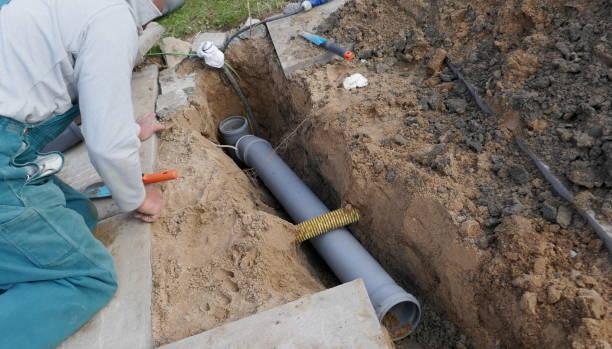Emergency Pipe Repair: What Homeowners Should Do First

When water starts flooding your floors or a pipe bursts behind your walls, panic can quickly set in. Pipe emergencies often happen without warning and can cause significant damage if not addressed promptly. Understanding how to respond in the first few moments is critical in minimizing harm to your home and avoiding expensive restoration.
Emergency pipe repair and replacement situations can vary, from frozen pipes cracking under pressure to corroded pipes suddenly leaking. Recognizing early warning signs and taking fast action can make the difference between a minor inconvenience and a major plumbing disaster.
Turn Off the Water Supply Immediately
The first and most important step is to shut off the main water supply. This prevents further flooding and helps isolate the damaged section of piping. In many Hurst TX homes, the shut-off valve is located near the water meter or in the basement, as advised by professionals like Drain One Plumbing.
If the issue is limited to a specific area, such as a leaking sink or toilet, turning off the local valve may be sufficient. For burst or cracked pipes, however, full shutoff is essential.
Identify the Source of the Leak
Once the water is off, try to locate the source of the problem. Common culprits include:
-
Leaking joints
-
Frozen pipes
-
Cracked or burst pipes
-
Corroded pipes
-
Loose fittings
In some cases, signs of pipe corrosion or discoloration around fittings may have been visible beforehand. Identifying whether the problem involves copper, galvanized, or PVC piping can help guide the next steps for pipe repair and replacement.
Mitigate Immediate Damage
After stopping the water, focus on damage control:
-
Use towels, buckets, or wet/dry vacuums to remove standing water.
-
Place a container under leaking joints to collect water.
-
Use fans and dehumidifiers to prevent mold growth, especially after underground pipe repair or slab leaks.
-
Take photos of the damage for insurance purposes.
These steps can reduce long-term structural harm and protect against costly restoration.
Assess Whether You Need Repair or Full Replacement
Not all pipe issues require total replacement. In many cases, plumbing pipe repair—such as sealing a leak or tightening a joint—can resolve the problem temporarily. However, full pipe replacement may be needed if:
-
The pipes are outdated or galvanized.
-
There's frequent clogging in clogged water lines.
-
You’ve had repeated pipe burst repair events.
-
You suspect corroded pipes or see rust buildup.
A licensed plumber can conduct a pipe inspection, using modern tools such as cameras to diagnose pipe damage signs in hard-to-reach areas.
Consider Trenchless and Modern Repair Options
Traditional pipe replacement methods often require digging into walls or floors. However, modern techniques like trenchless pipe replacement offer a less invasive alternative. This method involves inserting a new pipe liner inside the old pipe, avoiding the need for excavation.
Benefits include:
-
Faster turnaround time
-
Less damage to floors or landscaping
-
Long-term durability for residential pipe replacement
Prevent Future Pipe Failures
Once repairs are made, take steps to prevent future problems:
-
Insulate pipes to avoid frozen pipe repair situations.
-
Schedule regular pipe inspections to catch early warning signs.
-
Replace aging systems with modern materials such as PEX or copper.
-
Monitor for water pressure problems, as high pressure can damage pipes over time.
-
Maintain proper plumbing system hygiene to prevent buildup and clogged water lines.
Routine plumbing system maintenance ensures your home’s system runs efficiently and reduces the risk of future emergencies.
Conclusion
Emergency pipe repair and replacement situations can be overwhelming, but quick thinking and immediate action can protect your home from extensive water damage. Knowing how to shut off water, assess the damage, and seek professional help will give you the confidence to handle sudden pipe issues with ease. With routine maintenance and awareness of aging pipes, you can also prevent many of these emergencies from happening in the first place.
FAQs
Q1. How do I know if I need emergency pipe repair or full replacement?
If the pipe is old, corroded, or repeatedly leaking, full pipe replacement is more cost-effective long-term. Emergency repair is best for isolated leaks or bursts.
Q2. What are the signs of a leaking pipe behind a wall?
Look for discoloration, peeling paint, mold growth, or musty smells. These are common pipe damage signs indicating hidden leaks.
Q3. Can I repair a burst pipe myself?
Temporary fixes like pipe clamps or epoxy putty can help. However, pipe burst repair should always be followed by a professional evaluation.
Q4. What’s the average cost of trenchless pipe replacement?
On average, trenchless repair ranges between $3,000 and $6,000 depending on the length and depth of the pipe. It's less invasive than traditional methods.
Q5. How often should I inspect my plumbing system?
Experts recommend a full pipe inspection every 2–3 years, or more frequently for older homes with galvanized pipes or known issues.
- Art
- Causes
- Best Offers
- Crafts
- Dance
- Drinks
- Film
- Fitness
- Food
- Spellen
- Festival
- Gardening
- Health
- Home
- Literature
- Music
- Networking
- Other
- Party
- Religion
- Shopping
- Sports
- Theater
- Wellness



